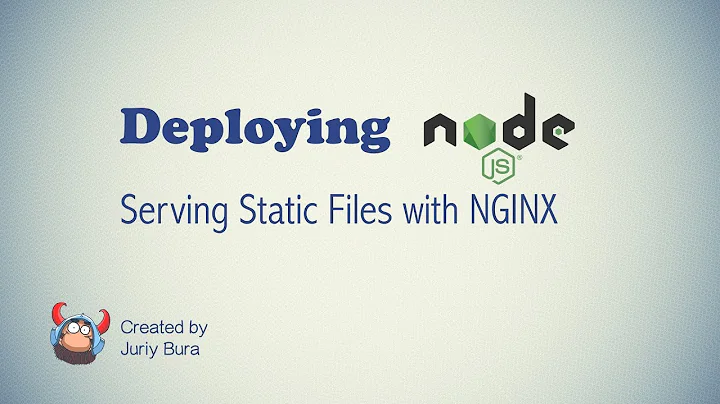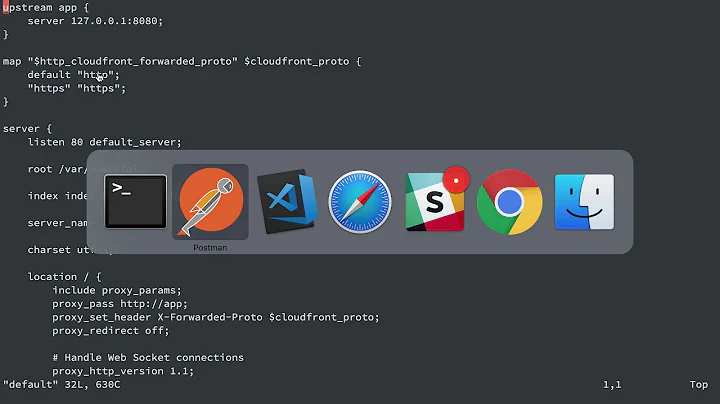How can I make nginx return a static response and send request headers to app?
Solution 1
A simple option is to terminate the client connection ASAP while proceeding with the backend process.
server {
location /test {
# map 402 error to backend named location
error_page 402 = @backend;
# pass request to backend
return 402;
}
location @backend {
# close client connection after 1 second
# Not bothering with sending gif
send_timeout 1;
# Pass the request to the backend.
proxy_pass http://127.0.0.1:8080;
}
}
The option above, while simple, may result in the client receiving an error message when the connection is dropped. The ngx.say directive will ensure that a "200 OK" header is sent and as it is an async call, will not hold things up. This needs the ngx_lua module.
server {
location /test {
content_by_lua '
-- send a dot to the user and transfer request to backend
-- ngx.say is an async call so processing continues after without waiting
ngx.say(".")
res = ngx.location.capture("/backend")
';
}
location /backend {
# named locations not allowed for ngx.location.capture
# needs "internal" if not to be public
internal;
# Pass the request to the backend.
proxy_pass http://127.0.0.1:8080;
}
}
A more succinct Lua based option:
server {
location /test {
rewrite_by_lua '
-- send a dot to the user
ngx.say(".")
-- exit rewrite_by_lua and continue the normal event loop
ngx.exit(ngx.OK)
';
proxy_pass http://127.0.0.1:8080;
}
}
Definitely an interesting challenge.
Solution 2
After reading here about post_action and reading "Serving Static Content Via POST From Nginx" http://invalidlogic.com/2011/04/12/serving-static-content-via-post-from-nginx/ I have accomplished this using:
server {
# this is to serve a 200.txt static file
listen 8888;
root /usr/share/nginx/html/;
}
server {
listen 8999;
location / {
rewrite ^ /200.txt break;
}
error_page 405 =200 @405;
location @405 {
# post_action, after this, do @post
post_action @post;
# this nginx serving a static file 200.txt
proxy_method GET;
proxy_pass http://127.0.0.1:8888;
}
location @post {
# this will go to an apache-backend server.
# it will take a long time to process this request
proxy_method POST;
proxy_pass http://127.0.0.1/$request_uri;
}
}
Solution 3
You may be able to accomplish this with post_action (I'm not entirely sure this will work, but it's the only thing I can think of)
server {
location / {
post_action @post;
rewrite ^ /1px.gif break;
}
location @post {
# Pass the request to the backend.
proxy_pass http://backend$request_uri;
# Using $request_uri with the proxy_pass will preserve the original request,
# if you use (fastcgi|scgi|uwsgi)_pass, this would need to be changed.
# I believe the original headers will automatically be preserved.
}
}
Related videos on Youtube
sandrew
Updated on June 04, 2022Comments
-
 sandrew 12 months
sandrew 12 monthsI am making a high-load web statistics system through embedding
<img>tag to site. The thing I want to do is:- nginx gets request for an image from some host
- it gives as answer to host little 1px static image from filesystem
- at this time it somehow transfers request's headers to application and closes connection to host
I am working with Ruby and I'm going to make a pure-Rack app to get the headers and put them into a queue for further calculations.
The problem I can't solve is, how can I configure sphinx to give headers to the Rack app, and return a static image as the reply without waiting a for response from the Rack application?
Also, Rack is not required if there is more common Ruby-solution.
-
 Michelle Tilley over 11 yearsThis is not really an answer to your specific question, but if you don't find another solution, you may consider logging the requests to a file and then parsing that file later with Ruby
Michelle Tilley over 11 yearsThis is not really an answer to your specific question, but if you don't find another solution, you may consider logging the requests to a file and then parsing that file later with Ruby -
 sandrew over 11 yearsBrandon, thanks, this solution is rather interesting, but I'm afraid, it is badly scalable.
sandrew over 11 yearsBrandon, thanks, this solution is rather interesting, but I'm afraid, it is badly scalable.
-
 greg over 10 yearsI do this with post_action. wiki.nginx.org/HttpEmptyGifModule is faster to serve a 1x1 gif.
greg over 10 yearsI do this with post_action. wiki.nginx.org/HttpEmptyGifModule is faster to serve a 1x1 gif.






